SUBJECTS
GRADE
Show Results
Help! I'm Falling!
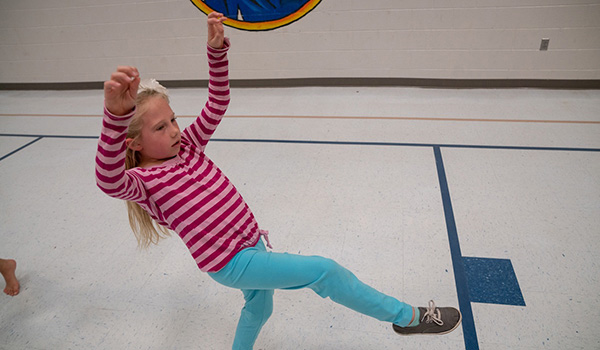
Lesson Summary
- Explore gravity, mass versus weight, and air resistance.
- Choreograph movement that appears to be in a zero-gravity environment.
Lesson Plan and Procedure
Lesson Key Facts
- Grade(s): 2, 3
- Subject(s): Dance, Science
- Duration of lesson: 45 minutes
- Author(s): Jana Shumway
Experience/Identify
Activity 1: Roller Coaster Ride!
Have every student line up behind you. Turn on “Banner Science Park” music.
Teacher: Buckle up and keep your arms and legs inside the car at all times. We’re going on a roller coaster ride!
Start running in curving pathways throughout the space. Move slowly when you go up a hill and faster when you go down a hill. When the ride comes to a stop, talk about why the roller coaster goes up slowly and down quickly. Gravity is a force that pulls the car down, yet gives resistance when it goes up. Therefore, when it goes against the gravitational force, it needs another force to help pull it up.
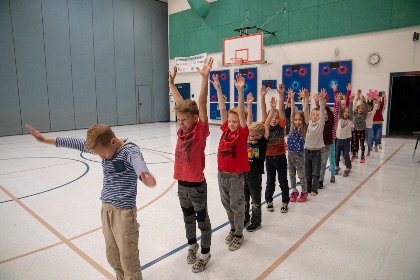
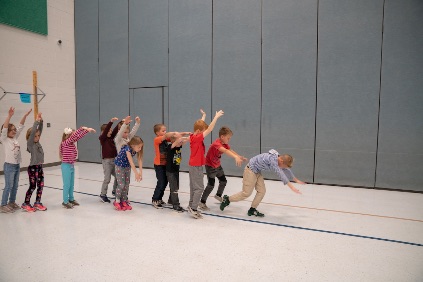
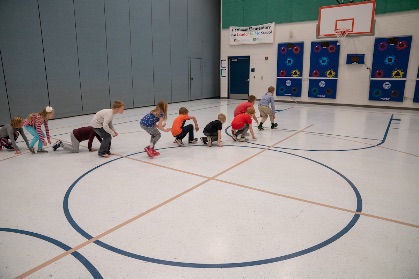
Activity 2: What Is Gravity?
Once again, have all the students line up behind you. Walk around the edges of the gym or classroom.
Teacher: We have just walked around the whole earth.
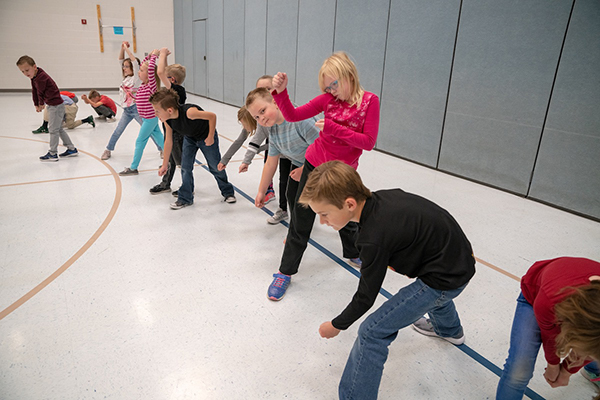 Line up students along one side of the room (one side of the “earth”) and have them “get out their shovels” and start digging as they travel in their own straight line to get to the other side of the room (have them do a jabbing, staccato movement with various body parts). Have them dig (jab and slash with arms, legs, heads, and shoulders) along their straight line until they’ve created a hole that goes from one side of the earth (North America) to the other side of the earth (Indian Ocean). Direct the students to get on the edge of the tunnel they just dug and jump in!
Line up students along one side of the room (one side of the “earth”) and have them “get out their shovels” and start digging as they travel in their own straight line to get to the other side of the room (have them do a jabbing, staccato movement with various body parts). Have them dig (jab and slash with arms, legs, heads, and shoulders) along their straight line until they’ve created a hole that goes from one side of the earth (North America) to the other side of the earth (Indian Ocean). Direct the students to get on the edge of the tunnel they just dug and jump in!
Teacher: Walk, jog, or run along the straight line you’ve just created with the following speed pattern: slow, medium, fast, really fast, fast, medium, slow, . . . suspend, . . . repeat going the other direction.
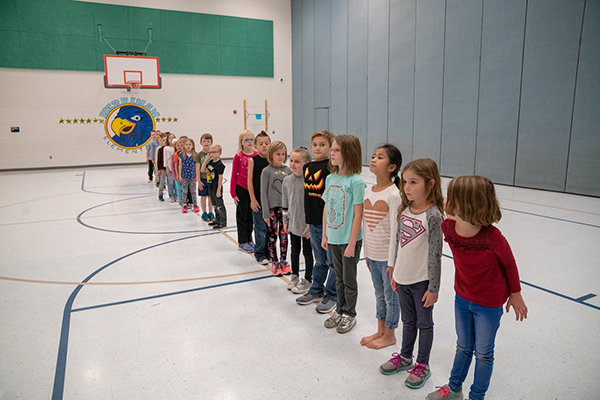 Each time they do that speed pattern, have them travel a shorter distance on the line until they’re stuck in the middle of their straight line. This is the mass where gravity is balanced. This would correlate to somewhere in the core of the earth.
Each time they do that speed pattern, have them travel a shorter distance on the line until they’re stuck in the middle of their straight line. This is the mass where gravity is balanced. This would correlate to somewhere in the core of the earth.
Activity 3: Mass versus Weight
Play “Rods and Cones” by Blue Man Group as you do this activity.
Teacher: Now climb out of the hole and start to skip. Notice the weight of your body as it lifts away from the earth and comes back down to the earth during the skip.
Have students try other locomotor steps (walk, run, jump, hop, leap, skip, slide, and gallop).
Teacher: Mass is the matter that makes up your body. The mass stays the same, no matter where you are. But the weight of your body will change, depending on the strength of the pull of gravity. Let’s go into space to see how this works.
In “outer space” have the students move lightly, as if they are floating. Have them land on the sun. Their bodies will feel like they weigh a ton. While the students are “on the sun,” have them try a variety of locomotor steps with an extremely heavy feeling.
Teacher: Leap heavily; hop heavily; gallop heavily; run heavily. It’s so hard to lift your legs, and sometimes you will even collapse because you can’t hold up your weight! Did you know that if you weigh 60 pounds on earth, you’ll weigh 1,680 pounds on the sun? That is super heavy!
Now have them fly and float to another planet. Visit several planets and at each one, call the students through different locomotor steps and have them adjust the heaviness or lightness of their movement according to how much gravitational pull there is (see below).



Someone who weighs 60 pounds on earth would weigh less than 60 pounds on Pluto, Mercury, Mars, Uranus, Venus, Saturn, or the moon. However, the person would weigh more than 60 pounds if he or she visited Neptune, Jupiter, or the sun. Have the students dance heavily or lightly according to the weights listed with each planet below.
LIGHTER THAN EARTH EARTH
Pluto 5 lbs Earth 60 lbs
Moon 10 lbs
Mercury 23 lbs HEAVIER THAN EARTH
Mars 23 lbs Neptune 67 lbs
Uranus 53 lbs Jupiter 142 lbs
Venus 55 lbs Sun 1,680 lbs
Saturn 55 lbs
Activity 4: Falling Objects
Hold two balls or objects that are the same size in your hands; one must be heavy and the other must be light.
Teacher: Which one will land first?
Allow students to make predictions. Drop the balls or objects, and show the students that they land at the same time. Then explain who Galileo is.
Teacher: Galileo was born in Italy. He was a great scientist, physicist, and inventor. He invented telescopes, compasses, and thermometers. One day he climbed to the top of the leaning tower of Pisa and dropped two balls, of different weights, and he discovered that they land at the same time.
 Turn on the song “Australia” by Cusco. Have everyone try slow-motion falling from high to low at the same rate. Try it again and, this time, have one student lead. Everyone else must fall at the same speed as the leader. Switch the leader. Remind the students to fall in creative ways (spiraling, twisting, melting, moving in a staccato style, zig-zagging, staying symmetrical as they fall, and so on).
Turn on the song “Australia” by Cusco. Have everyone try slow-motion falling from high to low at the same rate. Try it again and, this time, have one student lead. Everyone else must fall at the same speed as the leader. Switch the leader. Remind the students to fall in creative ways (spiraling, twisting, melting, moving in a staccato style, zig-zagging, staying symmetrical as they fall, and so on).
Activity 5: Air Resistance
Hold a flat piece of paper in one hand and a crumpled piece of paper in the other hand. Have students make predictions about which will land first. Drop the papers at the same time. Notice the flat paper landed last. That is because of air resistance creating a force that pushes up on the surface of the flat paper.
 Have the boys follow one leader while the girls have “air resistance.” The girls need to fall in their own individual timing, yet make sure that they all fall slower than the boys do, who are moving at the same rate. Switch and let the boys try the “air resistance.”
Have the boys follow one leader while the girls have “air resistance.” The girls need to fall in their own individual timing, yet make sure that they all fall slower than the boys do, who are moving at the same rate. Switch and let the boys try the “air resistance.”
If you desire, you can show the YouTube video “Hammer vs Feather - Physics on the Moon.”
Teacher: There is no air on the moon, so air resistance is not an issue. Therefore, all things will fall at the same rate on the moon.
Create/Perform
Teacher: Now, for fun, you will get to experience one full day without gravity!
Have the students get into groups of five, and have them think of five active things they do during the day. (Each child can pick one favorite idea, to make sure all kids’ ideas are used). Some examples might be the following: swinging on a swing, playing soccer, rolling down a hill, riding a skateboard, jumping on a trampoline, or skiing. Then have the students dance the ideas as if they had no gravity.
Teacher: The movement needs to (1) be really exaggerated and big; (2) go upside-down, sideways, or backwards; (3) be in slow motion, since you can’t control your movement as well without gravity; and finally, (4) start and end in a shape.
Have each group perform their dance for the rest of the class.



Connect/Analyze
Review the science concepts learned in this lesson:
- What is gravity?
- What is the difference between mass and weight?
- How do objects fall? What is air resistance?
- Who is Galileo?
- What can overcome gravity?
Read the book Gravity is a Mystery, by Franklyn M. Branley, to review and reinforce concepts learned.
Learning Objectives
- Demonstrate gravity as a force.
- Observe how forces cause change in speed.
- Observe falling objects and identify things that prevent them from reaching the ground.
- Create and perform movement with contrasting energies.
Utah State Board of Education Standards
This lesson can be used to meet standards in many grades and subject areas. We will highlight one grade’s standards to give an example of application.
Grade 3 Science with Engineering Education (SEEd)
- Standard 3.3.1: Plan and carry out investigations that provide evidence of the effects of balanced and unbalanced forces on the motion of an object. Emphasize investigations where only one variable is tested at a time. Examples could include an unbalanced force on one side of a ball causing it to move and balanced forces pushing on a box from both sides producing no movement. (PS2.A, PS2.B)
- Standard 3.3.2: Analyze and interpret data from observations and measurements of an object’s motion to identify patterns in its motion that can be used to predict future motion. Examples of motion with a predictable pattern could include a child swinging on a swing or a ball rolling down a ramp. (PS2.A, PS2.C)
- Standard 3.3.3: Construct an explanation that the gravitational force exerted by Earth causes objects to be directed downward, toward the center of the spherical Earth. Emphasize that "downward" is a local description depending on one’s position on Earth. (PS2.B)
Grade 3 Dance
- Standard 3.D.CR.2: Experiment with a variety of self-identified stimuli for movement, and explore a given movement problem by improvising, selecting, and demonstrating possible solutions.
- Standard 3.D.P.6: Identify, perform and describe movements and phrases with contrasting energy and dynamics.
Equipment and Materials Needed
- Book: Branley, Franklyn M., and Edward Miller. Gravity Is a Mystery. HarperCollins Publishers, 2007.
- Music recordings:
- "Banner Science Park" from the Universal Studios Islands of Adventure CD (roller coaster)
- "Rods and Cones" by Blue Man Group (mass versus weight)
- "Australia" by Cusco (falling objects)
- "Flying Things" by Peter Melnick
- Other media:
- YouTube video "Hammer vs. Feather - Physics on the Moon": https://www.youtube.com/watch?v=KDp1tiUsZw8
- Other materials:
- Two balls that are the same size: one heavy, one light
- Two pieces of paper: one flat, one crumpled
Additional Resources
- NASA Space Place is a website with a wealth of information: https://spaceplace.nasa.gov/what-is-gravity/en/
Image References
Image 1–14: Jana Shumway.

www.education.byu.edu/arts/lessons
 Download
Download